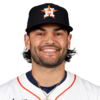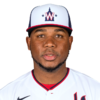2017 Fantasy Baseball Draft Prep: Carlos Rodon, Jorge Soler and nine other breakout candidates
Will these potential breakouts win your league for you? Heath Cummings nominates 11 players who could fit that bill.

There is no more exciting article to write each Fantasy Baseball season than this one. What is better than saying "these players who have never done this are suddenly going to do this!" and get away with it?
The answer, for me, is nothing.
We can argue over the specifics of what makes the perfect breakout candidate, but what you can't argue is their importance. You're going to miss on draft picks, everyone does. These are the players you can draft later who are going to come out of nowhere (or at least nowhere that would justify my 2017 expectations for them) to win you your league.
These are the guys who are going to make you look smarter than your friends and co-workers.
Isn't that what it's all about?
The importance of the breakout will be graded based on what their cost was and the performance they give you relative to that cost. So let's start with a player who will cost you almost nothing. Then we'll move on to specific categories.
Jorge Soler is the perfect breakout candidate in so many ways. We've seen his ability both in the minors (career .898 OPS) and in a very small sample size in the majors (.903 OPS in 97 PA in 2014). At the same time we've seen him struggle with both injuries and performance so much so that the defending world champions felt like they didn't have a place to play him and dealt him away.
Now at age 25, Soler will get a chance to play every day in Kansas City, likely as a right fielder in the middle of the order. Based on his first 200 career games, you should expect somewhere around a .760 OPS with 25 home runs and 85 RBI if he plays 150 games. That's a pretty solid middle ground for a player you can likely draft in the last round of the draft. That's also not touching on his potential.
This is a player who is just two years removed from being a consensus top-25 prospect. That consensus was based on Soler's 2014 that saw him hit 20 home runs in 333 PA across four different levels as a 22 year old. If Soler delivers on that type of power promise, he could challenge the most embarrassing record in baseball (Steve Balboni's team record 36 home runs in 1985).
Young Guns
When you look at the full season numbers for Carlos Rodon, it may look like he took a step back in 2016. Most notably, Rodon's ERA went up and his FIP paints a picture that the rise in ERA was not sheer luck. Rodon gave up twice as many home runs per nine innings and still won just nine games despite making five more starts. But that's only part of the story, and the other part is quite encouraging.
The most encouraging number for Rodon is his BB/9. He significantly lowered that number while slightly increasing his strikeout rate. If we assume that Rodon's increase in home run rate and BABIP allowed(.330) were at least somewhat exaggerated, we should expect a major improvement in 2017. We may have already seen the beginning of it.
I'm not generally a big fan of second half stats carrying over, but in a young pitcher those splits can be more instructive. Rodon threw 73 innings in the second half posting a 3.45 ERA, 9.5 K/9 and 2.7 BB/9. Unsurprisingly, his home run rate (0.99) and BABIP against (.303) normalized. If that was the beginning of what kind of pitcher Rodon is going to be now, we are looking at a bonafide Fantasy No. 2 starter.
Taijuan Walker is looking to challenge the record for the most consecutive years in someone's breakout column. He probably belongs in the next category, but I wanted to emphasize that Walker is still just 24 years old. He's six days younger than Jose De Leon. So if it makes you feel better, pretend like he spent the last two seasons dominating AAA instead of struggling in Seattle.
While Walker's fresh start in Arizona means a terrible park shift, the league shift is probably more important. Besides, Walker has shown enough upside in the past to succeed in any park. Like Rodon, Walker saw an explosion in home run rate last year, I'd expect that to normalize even in a bad park. He has swing-and-miss stuff and good control.
Walker's biggest problem in 2016 was his inability to get right-handed hitters out. He allowed an .809 OPS to righties largely because he does not yet have an effective breaking pitch. This is exactly the type of player you take a chance on as a change-of-scenery guy.
Aaron Nola started to have his breakout in 2016 but poor performance and injury derailed the whole thing. Now, looking back at those 2016 stats he looks like another struggling young pitcher. Nothing could be further from the truth.
Nola was one of only four pitchers last year with 100 innings pitched and a FIP below 3.10. The other three were Clayton Kershaw, Jose Fernandez and Noah Syndergaard. Nola wasn't in the class of the other three, but he wasn't anywhere close to as bad as his ERA suggested. The most exciting thing about his season was his jump in strikeout rate, because his control has always been good. Nola is an injury risk, but the Phillies expect him to be fully ready for camp.
Let's be honest, all Lance McCullers has to do to be a steal at his current ADP is throw 180 innings of the same ball he's thrown in his career. McCullers 2016 ERA perfectly matched his 2015 number, but that was the only thing that was similar.
McCullers saw a huge increase in both his K rate and BB rate in 2016 as well as a ridiculous spike in his BABIP allowed (.383). So what does the upside look like? How about 200 innings of 11 K/9 with a normalized walk rate and BABIP allowed. If the Astros win as many games as we expect them to, that may just put him in the running for the Cy Young with an ERA south of 3.00.
Better late than never
Miguel Sano was supposed to take another step in 2016 and be one of the few threats to the 30-100 club. Instead he struck out even more often than he did as a rookie, saw his BABIP regress, walked a lot less and missed a month with a hamstring injury. Some of these things were probably more predictable than others but the end result was disappointing nonetheless.
What is higher in 2017 for Miguel Sano?
— Heath Cummings (@heathcummingssr) January 18, 2017
For Sano, a 2017 breakout requires very little imagination. We're talking about a 23 year old with a 41 percent hard contact rate in 830 career plate appearances. You should expect a floor of 30 home runs if he stays healthy with an upside closer to 40. If the Twins offense is even a little bit better, that means 100 RBI again become the expectation.
Still, we need Sano to drop that strikeout rate to the 30-percent range if he's going to be an elite Fantasy option and post a batting average anywhere close to his rookie mark of .269. That's absolutely possible with Sano already showing the ability to improve his contact rate and plate discipline. The problem was that he took too many strikes.
It sounds funny, but Sano may need to actually swing more than he did last year.
If Miguel Sano was a disappointment last season, Maikel Franco was an absolute disaster. Franco's .733 OPS was largely unplayable as he failed to make the leap in an offense that provided next to zero protection. Of course, Franco also struggled in a completely different way. He can't match Sano's 40 percent hard contact rate, but he also strikes out less than half as often.
Franco's drop in batting average can be attributed at least partially to bad BABIP luck (.271), but he's never profiled as a high BABIP guy. He should get back above .270 this season, which is probably going to mean an OBP around .335. In other words, any breakout will mean a return of the power that left Franco in 2016. Fortunately, we've already seen him do it, posting a .217 ISO and a .497 SLG in 335 PA in 2015. Doing that over a full season with better luck will have Franco easily inside the top-10 at third base.
Much like Aaron Nola, Danny Salazar started to break out in the first half of 2016 but that was derailed by poor performance and an injury. Also like Nola, Salazar is expected to be 100 percent in 2017. Salazar is also a lot like Taijuan Walker in that he's someone who has been featured in breakout columns multiple times in the past. The two big differences are that he's three years older than Walker or Nola, and for my money, has even more upside.
Walks were a trouble for the Indians righty last season, but had never been before. In fact, Salazar's K/BB ratio of 3.7 would have been viewed as a strength heading into last season. Assuming Salazar gets those walk numbers under control, you're really just asking him to get through 32 starts for the first time in his career and he'll be a top 25 pitcher.
With a little bit of good fortune, on a team that should win a lot of games, Salazar could absolutely break out as a Fantasy ace.
Sophomore Studs
Nomar Mazara probably got more credit for his 20 home runs than he deserved in 2016. As Chris Towers has mentioned many times, Mazara's hard contact rate didn't line up with his home run rate at all. Those numbers suggest a serious drop in power.
If we were talking about an established veteran, I might be more concerned. Instead we're talking about a 21 year old who already has a full season under his belt at the major-league level and will be largely overlooked, especially in points leagues.
Even with the expected power drop, I see an increase in both doubles and walks. That should lead to a much more complete player in points leagues. I would also expect his runs and RBI numbers to improve as he inches closer to the middle of a very good Rangers order.
You can draft Mazara as a reserve outfielder, but I'd expect something closer to top-40 performance at the position.
Playing on a bad team isn't often a positive from a Fantasy perspective, but for Tim Anderson it could provide all the opportunity he needs to make the leap into the top 12 Fantasy shortstops in 2017. Anderson should bat at or near the top of the order in front of a decent core of Melky Cabrera, Jose Abreu and Todd Frazier.
Anderson doesn't have the pedigree of a Dansby Swanson or Orlando Arcia, but he's not a nobody either. He struggles with plate discipline and strikes out too often, but has the speed to make that .375 BABIP from 2015 seem close to reasonable.
Assuming he settles in and cuts his strikeout rate down closer to 20 percent, it wouldn't be all that surprising to see him flirt with a .300 average and 20-30 steals. That along with the run production that should come from a top-of-the-order slot could make him a three-category contributor in Rotisserie, which should be his best format.
Blake Snell's rookie season went very well and could have gone even better.
Snell proved that his bat-missing stuff translates to the majors and posted an ERA that was better than league average. In his final 14 starts, he had a 13 percent swinging strike rate that would have ranked in the top 10 of starters in 2016.
Snell has the stuff. He just needs to rein it in.
His walk rate was atrocious in 2016, but the fact that he was able to succeed despite it only speaks to his talent. His control improved slightly towards the end of the season, but there's every reason to suspect it will be at least a minor issue in 2017. Even if it is, Snell remains a premier breakout candidate because he's one step away from becoming a Fantasy ace.


































